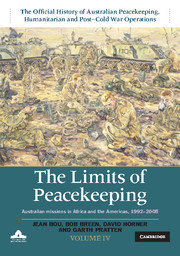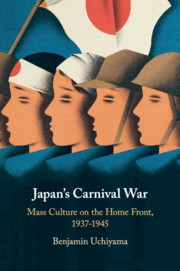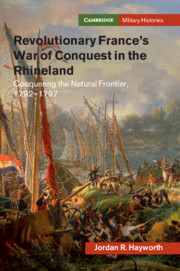Refine search
Actions for selected content:
15418 results in Military history
3 - Entropic Suffering and Ars Combinatoria: 1962–70
-
- Book:
- George Rochberg, American Composer
- Published by:
- Boydell & Brewer
- Published online:
- 21 May 2021
- Print publication:
- 15 April 2019, pp 68-99
-
- Chapter
- Export citation
Subject Index
-
- Book:
- George Rochberg, American Composer
- Published by:
- Boydell & Brewer
- Published online:
- 21 May 2021
- Print publication:
- 15 April 2019, pp 227-239
-
- Chapter
- Export citation
2 - The Long Road to Ars Combinatoria: 1943–63
-
- Book:
- George Rochberg, American Composer
- Published by:
- Boydell & Brewer
- Published online:
- 21 May 2021
- Print publication:
- 15 April 2019, pp 43-67
-
- Chapter
- Export citation
Contents
-
- Book:
- George Rochberg, American Composer
- Published by:
- Boydell & Brewer
- Published online:
- 21 May 2021
- Print publication:
- 15 April 2019, pp vii-viii
-
- Chapter
- Export citation

The Limits of Peacekeeping
- Australian Missions in Africa and the Americas, 1992–2005
-
- Published online:
- 13 April 2019
- Print publication:
- 10 October 2018
Contents
-
- Book:
- Japan's Carnival War
- Published online:
- 01 March 2019
- Print publication:
- 14 March 2019, pp v-vi
-
- Chapter
- Export citation
Conclusion
-
- Book:
- Japan's Carnival War
- Published online:
- 01 March 2019
- Print publication:
- 14 March 2019, pp 253-262
-
- Chapter
- Export citation
3 - The Soldier
-
- Book:
- Japan's Carnival War
- Published online:
- 01 March 2019
- Print publication:
- 14 March 2019, pp 105-161
-
- Chapter
- Export citation
Acknowledgments
-
- Book:
- Japan's Carnival War
- Published online:
- 01 March 2019
- Print publication:
- 14 March 2019, pp x-xii
-
- Chapter
- Export citation
Introduction
-
- Book:
- Japan's Carnival War
- Published online:
- 01 March 2019
- Print publication:
- 14 March 2019, pp 1-22
-
- Chapter
- Export citation
4 - The Movie Star
-
- Book:
- Japan's Carnival War
- Published online:
- 01 March 2019
- Print publication:
- 14 March 2019, pp 162-201
-
- Chapter
- Export citation
Bibliography
-
- Book:
- Japan's Carnival War
- Published online:
- 01 March 2019
- Print publication:
- 14 March 2019, pp 263-276
-
- Chapter
- Export citation
Copyright page
-
- Book:
- Japan's Carnival War
- Published online:
- 01 March 2019
- Print publication:
- 14 March 2019, pp iv-iv
-
- Chapter
- Export citation
1 - The Reporter
-
- Book:
- Japan's Carnival War
- Published online:
- 01 March 2019
- Print publication:
- 14 March 2019, pp 23-66
-
- Chapter
-
- You have access
- HTML
- Export citation
2 - The Munitions Worker
-
- Book:
- Japan's Carnival War
- Published online:
- 01 March 2019
- Print publication:
- 14 March 2019, pp 67-104
-
- Chapter
- Export citation
5 - The Youth Aviator
-
- Book:
- Japan's Carnival War
- Published online:
- 01 March 2019
- Print publication:
- 14 March 2019, pp 202-252
-
- Chapter
- Export citation
Index
-
- Book:
- Japan's Carnival War
- Published online:
- 01 March 2019
- Print publication:
- 14 March 2019, pp 277-280
-
- Chapter
- Export citation
Figures
-
- Book:
- Japan's Carnival War
- Published online:
- 01 March 2019
- Print publication:
- 14 March 2019, pp vii-ix
-
- Chapter
- Export citation

Japan's Carnival War
- Mass Culture on the Home Front, 1937–1945
-
- Published online:
- 01 March 2019
- Print publication:
- 14 March 2019

Revolutionary France's War of Conquest in the Rhineland
- Conquering the Natural Frontier, 1792-1797
-
- Published online:
- 11 February 2019
- Print publication:
- 06 February 2019
